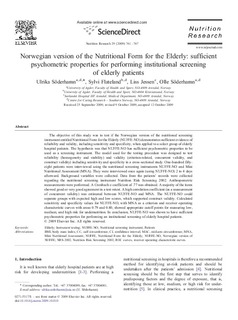| dc.contributor.author | Söderhamn, Ulrika | |
| dc.contributor.author | Flateland, Sylvi | |
| dc.contributor.author | Jessen, Liss | |
| dc.contributor.author | Söderhamn, Olle | |
| dc.date.accessioned | 2017-06-07T12:38:54Z | |
| dc.date.available | 2017-06-07T12:38:54Z | |
| dc.date.issued | 2009 | |
| dc.identifier.citation | Söderhamn, U., Flateland, S., Jessen, L. & Söderhamn, O. (2009) Norwegian version of the Nutritional Form for the Elderly: sufficient psychometric properties for performing institutional screening of elderly patients. Nutrition Research, 29(11), s. 761-7. | |
| dc.identifier.uri | http://hdl.handle.net/11250/2445035 | |
| dc.description | Artikkelen rapporterer en studie hvor hensikten var å teste den norske versjonen av ernæringskartleggingsinstrumentet Nutritional Form for the Elderly (NUFFE-NO) blant eldre pasienter i en institusjonssetting. | |
| dc.description.abstract | The objective of this study was to test if the Norwegian version of the nutritional screening instrument entitled Nutritional Form for the Elderly (NUFFE-NO) demonstrates sufficient evidence of reliability and validity, including sensitivity and specificity, when applied to a select group of elderly hospital patients. The hypothesis was that NUFFE-NO has sufficient psychometric properties to be used as a screening instrument. The model used for the testing procedure was designed to test reliability (homogeneity and stability) and validity (criterion-related, concurrent validity, and construct validity) including sensitivity and specificity in a cross-sectional study. One-hundred fifty-eight patients were interviewed using the nutritional screening instruments NUFFE-NO and Mini Nutritional Assessment (MNA). They were interviewed once again (using NUFFE-NO) 2 to 4 days afterward. Background variables were collected. Data from the patients' records were collected regarding the nutritional screening instrument Nutrition Risk Screening 2002. Anthropometric measurements were performed. A Cronbach α coefficient of .77 was obtained. A majority of the items showed good or very good agreement in a test-retest. A high correlation coefficient (as a measurement of concurrent validity) was estimated between NUFFE-NO and MNA. The NUFFE-NO could separate groups with expected high and low scores, which supported construct validity. Calculated sensitivity and specificity values for NUFFE-NO, with MNA as a criterion and receiver operating characteristic curves with areas 0.79 and 0.80, showed appropriate cutoff points for measuring low, medium, and high risk for undernutrition. In conclusion, NUFFE-NO was shown to have sufficient psychometric properties for performing an institutional screening of elderly hospital patients. | |
| dc.language.iso | eng | |
| dc.subject | pasientsikkerhet | |
| dc.subject | ernæring | |
| dc.subject | underernæring | |
| dc.subject | livskvalitet | |
| dc.subject | helse | |
| dc.subject | mat | |
| dc.subject | drikke | |
| dc.subject | måltid | |
| dc.subject | risiko | |
| dc.subject | forebygging | |
| dc.subject | ernæringsstatus | |
| dc.subject | kartlegging | |
| dc.subject | ernæringskartlegging | |
| dc.subject | screening | |
| dc.subject | institusjon | |
| dc.subject | sykehus | |
| dc.subject | eldre | |
| dc.subject | tverrsnitt | |
| dc.subject | tverrsnittstudie | |
| dc.subject | Nutritional Form For the Elderly | |
| dc.subject | NUFFE-NO | |
| dc.subject | validering | |
| dc.subject | testing | |
| dc.subject | Norge | |
| dc.title | Norwegian version of the Nutritional Form for the Elderly: sufficient psychometric properties for performing institutional screening of elderly patients | |
| dc.type | Journal article | |
| dc.rights.holder | Söderhamn, Ulrika | |
| dc.source.volume | 29 | |
| dc.source.journal | Nutrition Research | |
| dc.source.issue | 11 | |
| dc.identifier.doi | 10.1016/j.nutres.2009.10.010 | |
